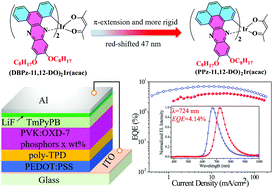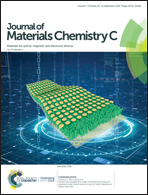Iridium(iii) phosphors with rigid fused-heterocyclic chelating architectures for efficient deep-red/near-infrared emissions in polymer light-emitting diodes†
Abstract
Deep-red/near-infrared (DR/NIR) OLEDs based on transition metal complexes have drawn much attention due to their potential applications in displays, bioimaging and photodynamic therapy. In this article, two novel iridium(III) complexes, (DBPz-11,12-DO)2Ir(acac) and (PPz-11,12-DO)2Ir(acac), were primarily designed and synthesized using highly rigid fused-heterocyclic phenazine derivatives as ligands. By tuning the benzo number in the phenazine, the iridium complexes exhibited significantly different emission characteristics. Strong NIR emission at 732 nm with a quantum efficiency of 13% and a lifetime of 0.60 μs was observed in the (PPz-11,12-DO)2Ir(acac) solution. In contrast, a remarkably blue-shifted DR emission at 685 nm with a quantum efficiency of 27% and a lifetime of 0.40 μs was exhibited in the (DBPz-11,12-DO)2Ir(acac) solution. As a result, both iridium complexes exhibited high-efficiency DR/NIR electroluminescence in their doped polymer light-emitting devices. The (PPz-11,12-DO)2Ir(acac) devices showed a maximum external quantum efficiency (EQE) of 4.14% with a radiance of up to 20 981 mW Sr−1 m−2, and the (DBPz-11,12-DO)2Ir(acac) devices afford an increased EQE of 7.04% with a radiance of 33 671 mW Sr−1 m−2. This strategy of using rigid fused-heterocyclic cyclometalated ligands has opened a new avenue for high-efficiency DR/NIR-emitting iridium complexes.



 Please wait while we load your content...
Please wait while we load your content...